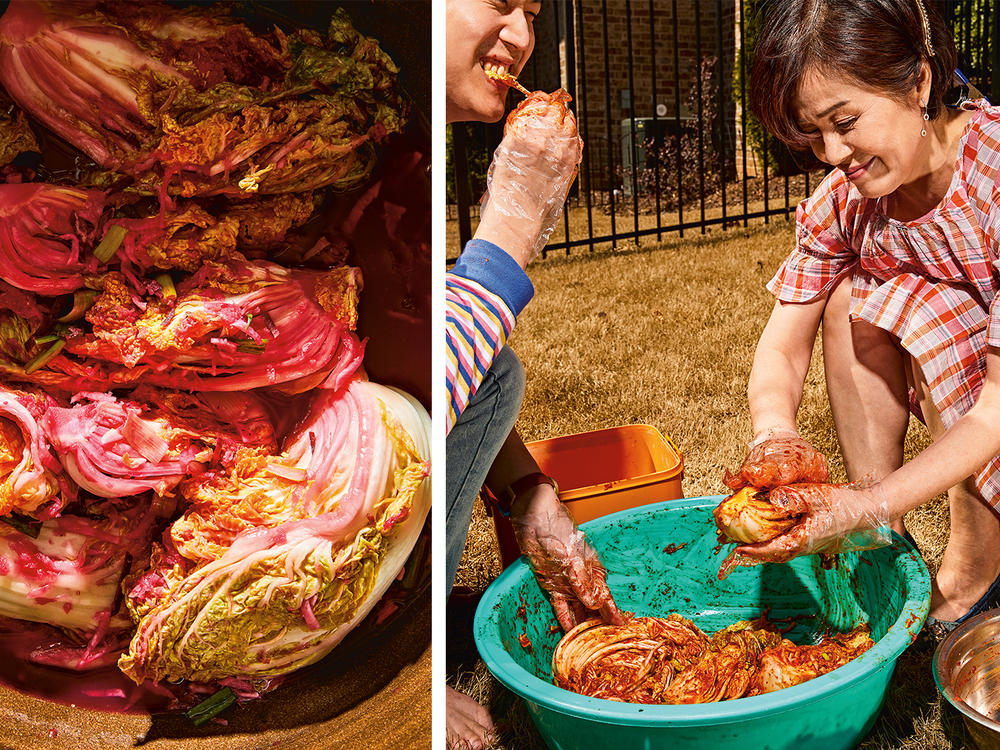Section Branding
Header Content
The one recipe you'll need to make your first batch of kimchi
Primary Content
Excerpted from Eric Kim's debut cookbook, Korean American: Food That Tastes Like Home. Check out Life Kit's guide with Eric Kim on how to start cooking Korean American food.
Jean's Perfect Jar of Kimchi
Yield: 1 gallon
Time: 4 hours
Consider this recipe the key that unlocks all the other levels of Korean home cooking (or at least the ones in this book). Jean worked especially hard to get this recipe to fit a one-gallon jar exactly with her tong baechu kimchi, or whole napa cabbage kimchi (where the leaves are kept together by the core, rather than chopped up into pieces first; in my opinion, this results in a much better-tasting ferment). She did this mostly out of obsessiveness, but also because: Is there anything more satisfying than a recipe that makes one perfect jar of a really good thing?
Ingredients
- 1 cup kosher salt
- 2 medium heads napa cabbage (about 2 pounds each), any dirty outer leaves removed, quartered lengthwise
For the perfect sauce
- ½ medium yellow onion, peeled
- ½ medium red apple, peeled
- ½ medium Korean pear (aka Asian pear), peeled
- 10 large garlic cloves, peeled
- 1-inch piece fresh ginger, peeled
- ¾ cup gochugaru
- ½ cup fish sauce
- ½ cup saeujeot (salted fermented shrimp; see page 25)
- 3 tablespoons maesil cheong (green plum syrup; see page 22)
- 1 pound Korean radish, peeled and cut into matchsticks
- 5 large scallions, cut into ½-inch pieces
Directions
1. Fill a large, wide tub with 6 cups cold tap water. Add the salt and stir to dissolve. Add the cabbage quarters to the water, making sure the inner leaves are all soaked by spreading them open slightly. Let the cabbage sit in the water cut-side up until wilted and seasoned throughout, about 3 hours, flipping once halfway through. The bowl will fill with more water as the salt draws liquid out of the cabbages.
2. Meanwhile, make the perfect sauce: In a food processor, combine the onion, apple, Korean pear, garlic, and ginger and process until smooth. Transfer to a large bowl—like, the largest you've got—and add the gochugaru, fish sauce, salted fermented shrimp, plum syrup, radish, and scallions. Stir to combine.
3. Drain and rinse the salted cabbage quarters in the sink, running them under the cold tap and squeezing them of their excess liquid. Place one cabbage quarter in the large bowl with the sauce and smear it all over the cabbage and in between all the leaves. When it's fully slathered inside and out, gather its wide leafy ends together and lay them over its root end, like you're swaddling a baby, essentially folding the whole thing in half. Place that gorgeous new kimchi baby into a 1-gallon jar. Repeat with the rest of the cabbage quarters, snugly placing one finished and swaddled bundle after another into the jar. You should be able to fill the entire jar with this amount of kimchi. Top the jar with any remaining kimchi sauce and loosely close with a lid.
4. You can start eating this kimchi as soon as you make it, though it won't gain its characteristic sourness until you let it sit. To do so: Store it at room temperature until it begins to ferment and sour, 2 to 3 days depending on the season and temperature of your kitchen. Refrigerate it after that for 2 to 3 weeks until fermented and up to 6 to 8 months.
NOTE: To house your kimchi while it ferments, the best option is a onegallon glass jar with a loose-fitting plastic lid. You can find this online and at any Asian grocery store. A stainless-steel jar with a metal lid comes in close second. The one thing you should not use is a mason jar with an airtight lid. When it comes to kimchi, the air needs somewhere to escape—to "fart," as I like to say.
In fact, whatever jar you're using, you'll want to check on your kimchi in its early stages, every 2 to 3 days, by opening the lid and taking a sterile utensil to press down on the top of the kimchi to release some gas. This isn't entirely necessary, but it's a useful way to get to know the fermentation process and how things work in your kitchen. It's also added insurance. Your jar could explode (though that's never happened in my lifetime, nor in my mother's, so I don't know why it keeps happening to people).
Copyright 2022 NPR. To see more, visit https://www.npr.org.

